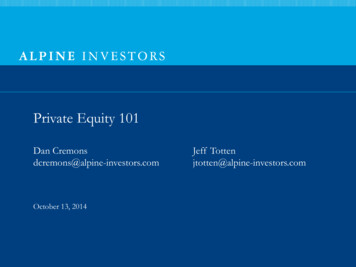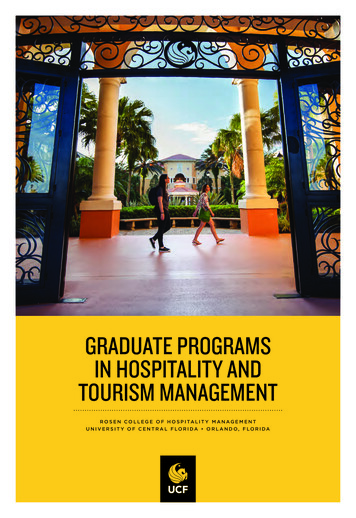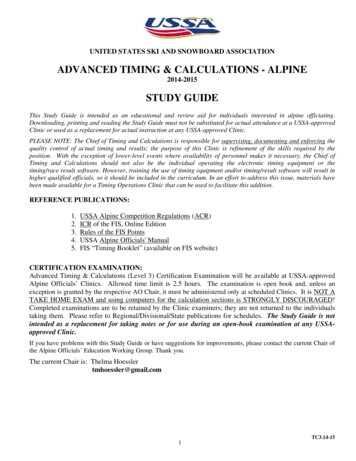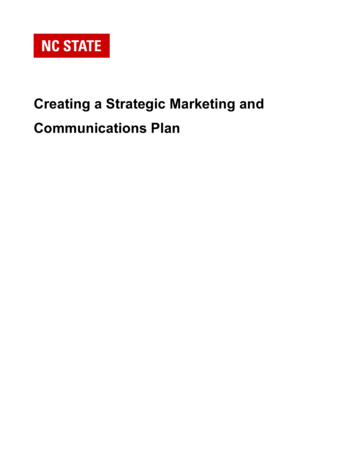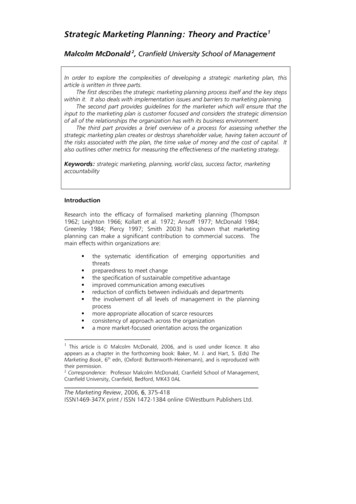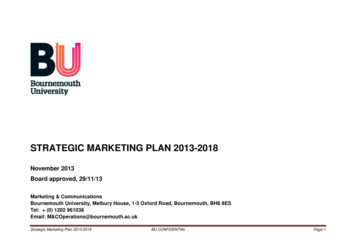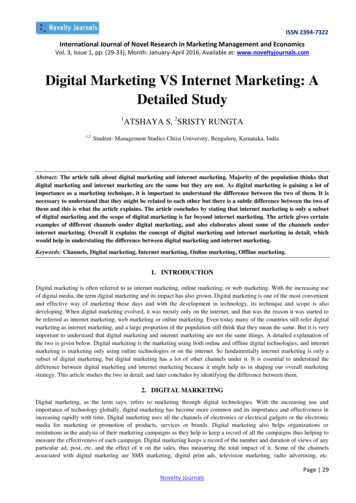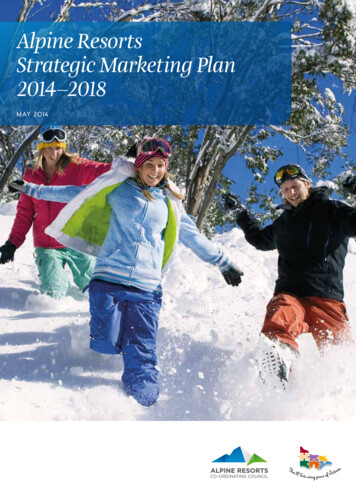
Transcription
Alpine ResortsStrategic Marketing Plan2014–2018MAY 2014
MI NI ST E R’ S FO R E WO R DVictoria’s alpine regions form an invaluable part of our state’s unique tourismoffering, providing spectacular and unspoilt environments that are also easilyaccessible from Melbourne and regional centres.Our ski resorts feature an extensive selection of European style lodges builtin the heart of the snow, which provide Australian and international visitorswith an immersive winter holiday experience.Each resort has its own individual proposition, with a broad range of propertiescatering to visitors’ various levels of skiing experience and holiday expectations.Uniquely for Australia, Victorian resorts enable visitors to ski right to theirdoorstep, making them an even more compelling tourism product offering.Together, Victoria’s alpine resorts represent a major tourism attraction forregional Victoria and are a significant economic contributor for our state,generating 580 million annually and creating over 5,500 fulltime equivalentjobs in winter alone, in 2013.Effective marketing of these resorts is a key priority for the Victorian Government,which has developed a coordinated approach that will minimise duplicationand maximise potential for visitation growth.Our vision is for Victorian alpine resorts to be vibrant, growing and sustainable places,delivering alpine recreational and tourism experiences that are available to all.The marketing support articulated in the Alpine Resorts Strategic Marketing Plan2014–2018 (ARSMP) will ensure our resorts build on their position asyear-round destinations of choice for visitors from all over Victoria, Australiaand the world.The strategy has four key goals, including: sustaining the winter market;growing the winter market; developing and promoting the green season;and facilitating and encouraging collaboration that creates a seamlessvisitor experience.The ARSMP identifies opportunities for the alpine tourism industry, rangingfrom State Government agencies of Alpine Resorts Co-ordinating Counciland Tourism Victoria, to regional and resort partners, and the private sector,and provides a framework for collaboration to deliver the Plan’s strategic goals.It has been developed following extensive consultation with the alpine tourismindustry and I look forward to working with all stakeholders to achieve thisimportant vision for our state’s 19.6 billion tourism sector.The Hon Louise AsherMinister for Tourism and Major Events
MI N IST E R’ S FO R E WO R DVictoria’s alpine resorts – Mount Baw Baw, Lake Mountain, Mount Hotham,Mount Buller & Mount Stirling and Falls Creek – are significant tourism andrecreational assets. The resorts attract over one million visitors each yearand, in winter 2013 alone, generated 580 million in Gross State Productand approximately 5,500 jobs.The vision of this Alpine Resorts Strategic Marketing Plan 2014–2018 is toestablish Victoria’s alpine resorts as ‘a year round, destination of choice’.The plan has been prepared in accordance with the Alpine Resorts(Management) Act 1997, which requires the Alpine Resorts Co-ordinatingCouncil to co-ordinate, in conjunction with Tourism Victoria, the overallpromotion of the alpine resorts. It is the first joint marketing plan across all theresorts, and has been prepared following an extensive industry and stakeholderconsultation period.The government recognises that Victoria’s alpine resorts are truly year rounddestinations. Many Victorians and visitors to the state have enjoyed a Victoriansnow holiday, and summer visitation to the alpine resorts continues to increaseeach year as the resorts expand their visitor experience offers.Yet the opportunity exists to better promote and increase visitation to ouralpine resorts. The Alpine Resorts Strategic Marketing Plan 2014–2018 identifiesthe need to grow the winter market by building awareness of and preferencefor a snow holiday among both domestic and international visitors, as well asdeveloping and promoting resort activities outside of the snow season.Cooperative marketing and communications will play a critical role in fosteringthe long-term growth of the alpine industry. Under this plan, key stakeholderswill collaborate to maximise the effectiveness of all marketing activity topromote our alpine resorts.The development of the Alpine Resorts Strategic Marketing Plan 2014–2018also delivers a key action of the Alpine Resorts Strategic Plan 2012.I commend the Alpine Resorts Strategic Marketing Plan 2014–2018 to youand encourage all Victorians to visit and enjoy our alpine resorts.The Hon Ryan SmithMinister for Environment and Climate Change3
A B B REV I AT ION S U S E D I N TH I S D O C U M E N TARCCALPINE RESORTS CO-ORDINATING COUNCILIVSINTERNATIONAL VISITOR SURVEYARIAGALPINE RESORTS INDUSTRY ADVISORY GROUPKPIKEY PERFORMANCE INDICATORARMBALPINE RESORT MANAGEMENT BOARDLTALOCAL TOURISM ASSOCIATIONNIEIRNATIONAL INSTITUTE OF ECONOMICARSMP ALPINE RESORTS STRATEGIC MARKETING PLAN2014–2018AND INDUSTRY RESEARCHASAAAUSTRALIAN SKI AREAS ASSOCIATIONNVSNATIONAL VISITOR SURVEYBARTBOARD FOR ALPINE RESORTS TOURISMPVPARKS VICTORIADEPIDEPARTMENT OF ENVIRONMENTRTBREGIONAL TOURISM BOARDAND PRIMARY INDUSTRIESSCLSKI CLUBS AND LODGESDESTINATION GIPPSLAND INCORPORATEDDGITNETOURISM NORTH EASTDNSW DESTINATION NEW SOUTH WALESTSMTOURISM SNOWY MOUNTAINSGSPGROSS STATE PRODUCTTVTOURISM VICTORIAHTSHOLIDAY TRACKING SURVEYYRTYARRA RANGES TOURISMPublished byTourism Victoria and the Alpine Resorts Coordinating Council,Melbourne, VictoriaMay 2014.Copyright State of Victoria 2014.This publication is copyright.No part may be reproduced by any process, except inaccordance with the provisions of the Copyright Act 1968.Designed by haildesign.com.auPrinted by Bambra PressCover Photo: Falls Creek Alpine Resort Management BoardISBN 978-1-74326-936-74ALPINE RESORTS STRATEGIC MARKETING PLAN 2014–2018
CO NT E NTSAbbreviations4Contents5Executive summary71Introduction and purpose82Background92.1Legislative and strategic framework92.2Victoria’s alpine resorts102.3General tourism trends123Visitation statistics – fast facts133.1Key visitation insights134Context144.1Overview144.2Consultation to inform theAlpine Resorts Strategic Marketing Plan144.3Recommendations154.4Way forward155New strategic direction175.1Vision175.2Goals175.3Overarching principles175.4Delivering the plan185.5Target markets195.6Goal 1: Sustain the winter market205.7Goal 2: Grow the winter market225.8Goal 3: Develop and promote the green season245.9Goal 4: Collaborate to create a seamlessvisitor experience266Implementation, reporting and funding286.1Implementation and reporting286.2Funding287Key performance indicators29Appendix305
Victoria’s alpine resorts are a majoreconomic pillar for the state, a keycomponent of the tourism industryand a valuable recreational resourcefor the community.6ALPINE RESORTS STRATEGIC MARKETING PLAN 2014–2018
E X E CU T I VE SUMMARYVictoria’s alpine resorts are a major economic pillarfor the state, a key component of the tourism industryand a valuable recreational resource for the community.Visitor preferences and expectations are changingand Victoria’s alpine resorts are experiencing worldwidecompetition from destinations that have, or are developing,high quality tourism facilities and experiences in spectacularalpine settings.The Alpine Resorts Strategic Marketing Plan 2014–2018seeks to enhance the competitive positioning of Victoria’salpine resorts as a year round destination and to growvisitation, yield and visitor expenditure over the next fiveyears. It is informed by global, regional and local traveltrends and visitor preferences as well as the needsof local industry and communities in the alpine region.The plan provides government, industry and communitywith clear direction on how the Victorian alpine industrywill work together to market the alpine resorts as a preferredyear round travel destination thereby generatingtourism growth.The plan addresses the need for a more strategic,co-ordinated approach to cooperative marketingas identified in the Alpine Resorts Strategic Plan 2012.It outlines actions for all industry stakeholders andco-ordinates their marketing efforts to maximise returnon investment.The vision of the Alpine Resorts Strategic Marketing Plan2014–2018 is to establish Victoria’s alpine resorts as‘a year round destination of choice’. To achieve this vision,the plan contains four goals, as outlined below, that areunderpinned by pragmatic strategies and actions.Goal 1 of the plan is to sustain the winter marketby cultivating customer loyalty from existing markets,including skiers/snowboarders and snow play visitors.A great snow experience will turn these visitors intoloyal followers who talk about and share theirexperiences with others.The plan identifies the need to grow the winter market(Goal 2) by building awareness of and preference fora snow holiday among both domestic and internationalvisitors. ‘Lifestyle Leaders’ have been identified asa key target market with a high propensity to travel.This group represents around 4.1 million people acrossall socioeconomic groups and makes up 29 per centof Australia’s population.The plan also outlines the opportunity for the alpineresorts to diversify their visitor base by developing andpromoting the green season (Goal 3). Further, there is aneed for the industry to collaborate to create a seamlessvisitor experience (Goal 4) by improving marketingeffectiveness and communication channels at all levels,thereby enhancing the visitor experience and growingthe market. This will include streamlining the customerjourney in both the online and offline environment andcreating a seamless experience.All four goals are fundamental to visitor growthto the alpine resorts and broader region.7
1 I NTRODUCT ION AN D PUR POSEVictoria’s alpine resorts are significant tourism and recreation assets benefitingthe local, regional, Victorian and Australian communities and attracting over onemillion visitors annually. In 2013 it has been estimated that the alpine resorts ineconomic terms, generated 580 million in Gross State Product (GSP) and createdmore than 5,500 jobs in winter alone1. The alpine ecosystems are also significantfor their intrinsic values and nature conservation purposes and they provide thecommunity with an opportunity to interact with the unique alpine environment.In the rich and complex management landscape of the alpineresorts, effective marketing and communications plays acritical role in ensuring long-term growth of the sector.The purpose of the Alpine Resorts Strategic Marketing Plan2014–2018 (ARSMP) is to set the Victorian Government’sdirection, outline opportunities for industry andco-ordinate the marketing of Victoria’s alpine resortsat a national, state, regional and resort level. The planarticulates how key stakeholders will work togetherto promote Victoria’s alpine industry, maximising theeffectiveness of all activity to generate growth outcomes.The plan details actions to be carried out at a state,regional and resort level.Growth in the alpine industry will not happen without acohesive and co-ordinated approach by the alpine industry.The four strategic goals are:1234Sustain the winter marketGrow the winter marketDevelop and promote the green seasonCollaborate to create a seamless visitor experience.Six guiding principlesSix guiding principles underpin these goals and are criticalto the ongoing growth of the Victorian alpine resorts.THE GUIDING PRINCIPLES ARE:1The National Institute of Economic and Industry Research (NIEIR)undertook and extensive study of the winter season in 2011, TheEconomic Significance of the Australian Alpine Resorts Winter Season 2011,prepared for the ARCC, December 2012, building on an earlier 2005study, to determine the economic significance of Australian alpineresorts. NIEIR has estimated the economic contribution of the 2013winter season, taking into account season’s visitation and changes ineconomic conditions.8ALPINE RESORTS STRATEGIC MARKETING PLAN 2014–20181Put the visitor first2Be results orientated3Make informed and evidence based decisions4Innovate for change5Capitalise on competitive advantages6Take a collaborative approach.
2 BACKGROUN D2.1Legislative and strategic frameworkThe Alpine Resorts (Management) Act 1997 (the Act)requires the Alpine Resorts Co-ordinating Council (ARCC)to co-ordinate, in conjunction with Tourism Victoria (TV),the overall promotion of the alpine resorts (Section 18(b)).The Act also requires the Alpine Resort ManagementBoards (ARMBs) to contribute, together with TV and theARCC, to the overall promotion of the alpine resorts(Section 38(b)). It requires each ARMB to develop atourism and marketing strategy for their alpine resort.The Act also requires the preparation of an Alpine ResortsStrategic Plan and its review by the ARCC every five years.Following the review of the previous plan, the VictorianGovernment endorsed a new Alpine Resorts Strategic Plan2012 (2012 Plan)2 in December 2012. The 2012 Plan tooka holistic approach to the challenges facing the alpineindustry and presented an integrated strategic response.The 2012 Plan emphasised the importance of winter asthe ‘economic engine’ for the alpine resorts. It identifiedthe need for a more strategic, co-ordinated approach tomarketing that better utilises the resources that the variousalpine industry stakeholders are committing to marketingefforts. The development of the ARSMP and an integratedmodel for overall alpine promotion were outlined as keyto achieving this outcome.The ARCC and TV are responsible for the developmentand successful implementation of the integrated modeland have undertaken extensive stakeholder consultation,including the preparation of a background paper,to inform development of the draft ARSMP.The ongoing involvement of key industry stakeholders willensure that marketing of the alpine resorts is integrated andthe industry has ownership. The recently established AlpineResorts Industry Advisory Group (ARIAG)3 will assist here.32Alpine Resorts Strategic Plan 2012, Victorian Government, December 2012.ARIAG was formed to provide an ongoing mechanism for discussion ofindustry driven issues, including marketing, and the following groups havesenior representation: on-mountain businesses, lift companies, alpineindustry associations, local government and Tourism North East (TNE).9
2.2Victoria’s alpine resortsVictoria’s six alpine resorts are significant recreational and tourism attractions for Victoria, located in the nationallysignificant Australian Alps landscape, between two and five hours drive from Melbourne (see Figure 1).Figure 1: Victoria’s alpine resortsWodongaWangarattaBrightMt lState ForestParks and Nature Conservation Reserves110Mt Baw Baw2Lake Mountain3Mt Buller / Mt StirlingALPINE RESORTS STRATEGIC MARKETING PLAN 2014–20184Mt Hotham5Falls Creek
THE INDI VI D UAL ST RENGT H S O F T HE A LPINE R E SO RTSEach resort has its own unique proposition and attracts different types of visitors.Within cooperative marketing programs it is imperative that the strengths of eachresort are well identified, aligned to target markets, and clearly communicated.The competitive strengths identified by each alpine resort, are:Mount Baw BawEntry-level skiing and snowboarding facilities; a relatively low-cost snow experience; family-friendly; a growing nature-based/outdooreducation role; proximity to Gippsland and the growing outer eastern suburbs of Melbourne; access to Baw Baw Plateau.Lake MountainClose to Melbourne; offers snow and green season nature-based adventure activities, including excellent cross country ski trails,toboggan slopes and areas for snow playing families with tubing, laser skirmish and tree based activities on offer in both seasons;mountain biking and walking trails; a low cost entry-level snow experience with very easy vehicle access to and from Marysville thatoffers an array of complimentary visitor experiences.Mount HothamKnown as the ‘skiers’ mountain’ due its steep alpine slopes, advanced remote terrain and reliable snow cover with relatively goodresilience to climate variability; an airport which provides easy access to both domestic and international visitors; unique location(on top of the ridge) providing 360 degree panoramic views; door-to-door and dual village access; an extensive and diverse rangeof iconic walks including the Falls to Hotham Alpine Crossing, which caters to all levels and highlights the rich history of the region;four-wheel drive touring and the High Country Road to Great Alpine Road.Falls CreekIntimate village atmosphere with ski-in/ski-out accommodation; a broad range of snow sport options supported by evendistribution of terrain. It is the national home of cross-country skiing and has snowmaking capacity. Rocky Valley Lake also provideswater-based green season activities; the Falls to Hotham Alpine Crossing icon walk and proposed world-class altitude training andhealth facilities to augment unique natural training environment.Mount Buller & Mount StirlingHas strengths in both winter and green season: beginner to advanced terrain; good access and proximity to Melbourne;respected mountain biking positioning; good village amenities (almost a town); ‘raw’ natural appeal of Mount Stirling.11
2.3General tourism trendsThe number of Australians travelling overseas has grownsteadily over recent years. This has come at a cost to thedomestic tourism sector, which has remained relativelystatic over the past decade.The major factors affecting travel and tourism behaviour are: The relatively strong Australian dollar continues toreduce the competitiveness of Australia as a destination,and makes outbound travel more attractive to thedomestic market The growth in the number of low-cost carriers,increases in airline seat capacity and holiday dealscontinue to make travelling overseas easier and moreaffordable, leading to increased outbound travel The changing nature of household consumption hasimpacted domestic tourism’s share, with a shift towardsother categories for example, home entertainmentsystems, renovations Visitors seeking unique experiences as internationaltravel becomes more accessible, travellers are becomingmore discerning Growth in Asian markets has seen Chinese visitorsto Victoria more than double from the year endingDecember 2005 to December 20134. In the yearending December 2013, Victoria attracted 322,500Chinese visitors Low regional dispersal of the growing Asian marketscompared to some of the more traditional westernmarkets Rise of the internet in the year ending December 2013,61 per cent of international overnight visitors used theinternet as an information source either prior to and/or during their trip and 47 per cent booked at least onecomponent of the trip online5 Technology is also playing a critical role in the changingtravel patterns of Australians. In 2012, Australia hadover 19.5 million internet users, representing 89 percent of the population6. Technology is shifting the waypeople plan and book their travel: nearly 40 per centof all consumers in Australia purchased travel onlinein 20127. Australians’ technology requirements are alsoincreasing, as they require access to travel informationpre, during and post their travel purchase decisions.Competitive market snow trends:Australia – Over the last 10 years the number of ski visitsto the Australian alpine resorts has been relatively stableNew Zealand – Since 2004 visitation to the New Zealandsnowfields has grown to more than a million people per yearJapan – The popularity of skiing in Japan peaked in the 1990s,since then the number of skiers has declined. Japan is nowtargeting the international market, in particular Australia.456712ALPINE RESORTS STRATEGIC MARKETING PLAN 2014–2018International Visitor Survey, Tourism Research Australia,year ending December 2013.International Visitor Survey, Tourism Research Australia,year ending December s-in-australia
3 VIS ITAT ION STAT I ST I C S – FAST FAC TSThis plan has been developed on visitation statistics and research relevant to thealpine resorts and general tourism trends. A detailed analysis of the research isavailable in Appendix 1. The Victorian alpine resorts attract more than one millionvisitors per year. A snapshot of this data is outlined below:Winter In 2012 there were 771,000 visitors and in 2013there were 588,000 visitors Long term trend data shows that, on average,visitation has increased by 0.9% per annum in theperiod 1998–2013 73 per cent of day trip visitors to the alpine resortscome from Victoria 50 per cent of overnight visitors come from NSW International visitation represents less than 3 per centof the overall market with a majority of these visitorscoming from eastern hemisphere markets (73 per cent).Summer In 2012–13, there were 345,000 visitors to Victoria’salpine resorts Visitation has increased by 1.2 per cent per annumsince 2007/08 Overall, Victorians are the most important market(76 per cent) International visitation represents 2 per cent of theoverall market with the majority of these visitors comingfrom western hemisphere markets (54 per cent).3.1 Key visitation insightsThe following key research insights have informedthe development of this plan: Short break stays are on the increase in domestic markets Visitors from Southeast Asian markets have the highestpropensity to visit the alpine resorts as an add-onto their winter Melbourne holidays NSW continues to be an important marketfor overnight visitation Aviation access provides shorter travel timesfor key markets Skiing in Australia is perceived as a high cost,low value proposition The use of technology to research and book travelcontinues to increase Visitors are seeking unique and authentic experiences Climate change will continue to be a key challengefor the alpine resorts.13
4 CONTE X T4.1 OverviewThe Victorian Government has undertaken cooperativemarketing activities for the alpine resorts for overtwenty years. From 1999 to 2013, these activities wereco-ordinated by the Board for Alpine Resorts Tourism (BART).BART was established in 1999 to fulfill legislativerequirements set out in the Act. TV, the ARMBs and theARCC were all represented on BART. Over the course of15 years, BART’s activity evolved from an interstate brandmarketing campaign targeting NSW, SA and QLD, to amore diversified role. With each version of its strategicplan, BART attempted to diversify and grow its programand, as such, resulted in a much broader winter andgreen season program. A review of BART’s activitieswas undertaken during development of this plan;refer to Appendix 2.As directed by the Minister for Environment andClimate Change, BART was disbanded on 31 October2013. This followed a recommendation in the 2012 Planto develop an integrated model for marketing the alpineresorts to better utilise the resources alpine industrystakeholders are committing to marketing efforts.This new model includes: Development of a state-wide marketing strategybased on broad industry consultation and input Creation of a simpler, more streamlined process A longer-term strategic approach to marketing the sector Alignment of marketing activities at all levels(international, national, state, regional and resort level)with the state-wide plan, but allowing for flexibility torespond to industry needs and market forces Two-way transparency and accountability.The 2012 Plan also highlighted the importance of winter asthe ‘economic engine’ for the alpine resorts, well recognizingthe importance and opportunity to grow the green seasonmarket. The majority of current marketing activities arefocused on the winter season. In 2011, the Victorian alpineindustry spent an estimated 7 million on domestic andinternational marketing activities, taking into account bothpublic and private sector budgets. This included ARMBand BART annual statements suggesting that they spent atotal of approximately 4.5 million.14ALPINE RESORTS STRATEGIC MARKETING PLAN 2014–2018The key to a successful,sustainable and, mostimportantly, financiallyviable future for thealpine resortsis to maintain anintegrated approachtowards marketing.4.2 Consultation to inform the AlpineResorts Strategic Marketing PlanChallengesThe consultation highlighted a range of challenges, including: A significant degree of industry fragmentationand duplication of activities Lack of research to inform and co-ordinatemarketing activities Visitation leakage to overseas – a perceptionthat New Zealand is cheaper Negative value propositionand undifferentiated products Insufficient infrastructure to cater for the changingmarket, in particular broader products to target snowholiday/snow play visitors Insufficient cooperation, limited trust and collaborationbetween key organisations and stakeholders,particularly at a regional and resort level (Alpine ResortsManagement Boards (ARMBs), lift companies, Chambersof commerce and Regional Tourism Boards (RTBs)) The strong partnership formed between DestinationNew South Wales (DNSW) and the NSW snow resortsin 2014 will create significant competition.
4.3 Recommendations4.4 Way forwardThe following recommendations and opportunities forimprovement were identified from the consultation sessions:To ensure that the Victorian alpine resorts remainattractive and competitive destinations, the alpinemarketing activities require long-term commitments. Interrogate the existing brands,and test their market effectiveness The Victorian alpine industry needs to speak with aclear and consistent voice against competitive markets Each alpine resort should clearly differentiate andposition their winter and green season experiences toattract visitors in line with their product strengths Match products and infrastructure to market demands Alpine resorts need to work collaboratively withregional communities through the RTBs Build effective industry structures at all levels Improve stakeholder engagement and communicationson marketing activities at all levels Use research to inform and measurethe effectiveness of activities Harness technology to understand and communicateto visitor markets Understand the different product and marketing needsof the winter and green seasons Leverage partnerships to maximise opportunities Capitalise on the growing short break stay market,including opportunities associated with aviation access Continue to work with ski clubs and lodges to offera wider range of accommodation optionsAs described earlier, the alpine industry has the opportunityto harness the broader changes occurring in tourism trendsand travel behaviour. Existing and previously successfulproducts and marketing activities require a refreshin order to be aligned according to current consumerpreferences. The key components of this are for theindustry to market snow holiday experiences rather thanskiing holiday packages and to address the perceptionof a negative value proposition through product andindustry development. Research and market intelligenceare essential to understanding the new markets and theirrespective preferences.The key to a successful, sustainable and, most importantly,financially viable future for the alpine resorts is to maintainan integrated approach towards marketing. All industrystakeholders need to be involved in the implementationof this marketing plan in order to increase visitation,yield and expenditure across the alpine resorts, regions,and state.15
The 2012 Plan also highlighted theimportance of winter as the ‘economic engine’for the alpine resorts, well recognizingthe importance and opportunityto grow the green season market.16ALPINE RESORTS STRATEGIC MARKETING PLAN 2014–2018
5 NE W ST R AT EG IC DIR E C TIO NThis plan provides a five-year strategic framework formarketing Victoria’s alpine resorts. The following sectionoutlines the vision, goals and marketing strategies ofthe resorts.The plan is informed by global, regional and local traveltrends and visitor preferences as well as the needs of localindustry and communities in the surrounding alpine resortsregion. It provides a clear pathway for the growth andsustainability of the visitor economy within the regions.5.1 VisionThe vision of the plan is:‘The Victorian alpineresorts will be a year rounddestination of choice’.5.2 GoalsFour goals have been identified as criticalto the delivery of this plan:1234Sustain the winter marketGrow the winter marketDevelop and promote the green seasonCollaborate to create a seamless visitor experience.5.3 Overarching principlesSix overarching principles underpin the development anddelivery of this plan and have been applied to all goals,strategies and actions. These are:123456Put the visitor firstBe results orientatedMake informed and evidence-based decisionsInnovate for changeCapitalise on competitive advantagesTake a collaborative approach.17
5.4 Delivering the planTo deliver this plan many partnerships need to exist, and collaboration is needed at a national, state, regional and resort level.LevelStakeholdersNational partnersTourism Australia*State partnersTourism VictoriaAlpine Resorts Co-ordinating CouncilAustralian Ski Areas Association (Victorian members)Regional partnersRegional Tourism Boards, including:Tourism North EastDestination GippslandYarra Ranges TourismResort partnersAlpine Resort Management BoardsLift companiesChambers of commerceSki Clubs and Lodges*Leverage opportunities where possibleRoles and responsibilitiesRegional partnersClarification around the roles of all stakeholders is criticalto marketing the alpine resorts effectively and contributingto long-term growth. This plan redefin
Cooperative marketing and communications will play a critical role in fostering the long-term growth of the alpine industry. Under this plan, key stakeholders will collaborate to maximise the effectiveness of all marketing activity to promote our alpine resorts. The development of the Alpine Resorts Strategic Marketing Plan 2014-2018
